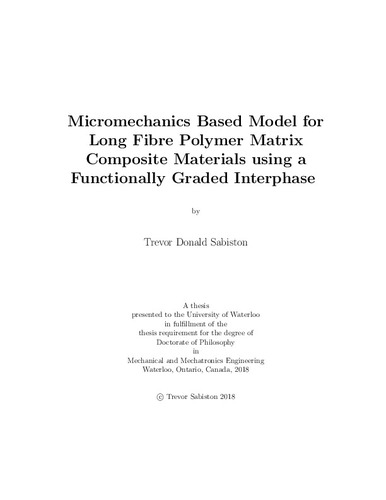| dc.contributor.author | Sabiston, Trevor Donald | |
| dc.date.accessioned | 2018-06-11 19:41:52 (GMT) | |
| dc.date.available | 2018-06-11 19:41:52 (GMT) | |
| dc.date.issued | 2018-06-11 | |
| dc.date.submitted | 2018-06-06 | |
| dc.identifier.uri | http://hdl.handle.net/10012/13395 | |
| dc.description.abstract | In order to incorporate more composite materials in mass production vehicles within the automotive industry, compression moulding manufacturing techniques have been de- veloped. Using processes such as Sheet Moulding Compound (SMC), and Direct Long Fibre Thermoplastic (DLFT), composite parts can be manufactured at a cycle time quick enough for use in mass production vehicles. Composites present a large opportunity to reduce vehicle mass as they have high specific strength and stiffness compared to metallic structural materials. They also do not corrode and are more formable then equivalent metallic materials. However, in order to design a vehicle in the virtual space one needs to be able to accurately predict the response of the materials used in crash simulations.
The microstructure of SMC and DLFT parts is very different from the laminated com- posite structures used in other industries. The orientation of the fibres in the material changes during the manufacturing process. The resulting fibre orientations are three di- mensional in nature. The existing theories that have been developed for modelling lami- nated two dimensional composite materials are not applicable to these materials, especially for predicting material failure. To predict failure in composite materials details of the mi- cromechanics are required, as they drive the failure phenomena. A framework which is three dimensional and takes the fibre orientation into account is required to accurately model these material systems.
A micro mechanics homogenization technique is developed where the material proper- ties in the region surrounding the fibre change as a function of position within a unit cell representative of the composite. The change of properties around the fibre is known as a functionally graded interphase (FGI). This modelling method quasi satisfies the equilib- rium condition between the fibre and matrix. Through the use of an interphase instead of an interface, it allows any number of aligned fibres to be represented as a single represen- tative fibre. The stresses in the fibre and matrix are combined to predict the elastic stress strain response of a composite.
A generalized solution to this problem is developed, where the stress changes as a func- tion of position within the FGI. This allows the modelling framework to be applied to instances where the matrix material is plastically deforming. The strain in the representa- tive fibre is determined using Eshelby’s solution to the inclusion problem from the strain applied to the far field of the composite unit cell (or finite element). Since the strain in the representative fibre and bulk matrix material is different a third deformation region called the interphase matrix is included within the FGI and accommodates the additional strain through a compatibility condition. The resulting solution allows for the stress and
iv
strain in the fibres, the bulk matrix and the matrix material adjacent to the fibre to be separately determined and used in the prediction of failure.
The model is further developed by considering what happens when a composite material is unloaded and the stresses return to zero. The elastic strain in the bulk matrix material is related to the elastic strain in the fibre allowing for a more direct method of strain partitioning when the matrix is plastically deforming around an elastic inclusion. This is more computationally efficient than existing methods for incremental strain partitioning.
To incorporate fibre orientation in the model, a discrete number of representative fibre orientations are considered. A volume fraction of fibres is assigned to each of these orienta- tions to predict the homogenized response of a compression moulded composite. Through studying three SMC microstructures under various applied strains it is determined that sixty representative fibres and associated fibre volume fractions are required to predict the response of an SMC material. This can be used to predict the response of the composite material required for the development cycle of new vehicles for the automotive industry. | en |
| dc.language.iso | en | en |
| dc.publisher | University of Waterloo | en |
| dc.subject | Composites | en |
| dc.subject | Micromechanics | en |
| dc.subject | Homogenization | en |
| dc.subject | Finite Element Analysis | en |
| dc.subject | Long Fibre | en |
| dc.subject | Sheet Moulding Compound | en |
| dc.title | Micromechanics Based Model for Long Fibre Polymer Matrix Composite Materials using a Functionally Graded Interphase | en |
| dc.type | Doctoral Thesis | en |
| dc.pending | false | |
| uws-etd.degree.department | Mechanical and Mechatronics Engineering | en |
| uws-etd.degree.discipline | Mechanical Engineering | en |
| uws-etd.degree.grantor | University of Waterloo | en |
| uws-etd.degree | Doctor of Philosophy | en |
| uws.contributor.advisor | Inal, Kaan | |
| uws.contributor.affiliation1 | Faculty of Engineering | en |
| uws.published.city | Waterloo | en |
| uws.published.country | Canada | en |
| uws.published.province | Ontario | en |
| uws.typeOfResource | Text | en |
| uws.peerReviewStatus | Unreviewed | en |
| uws.scholarLevel | Graduate | en |

